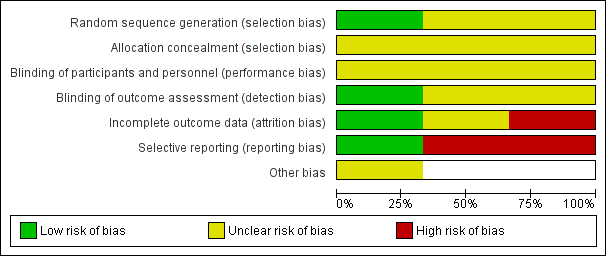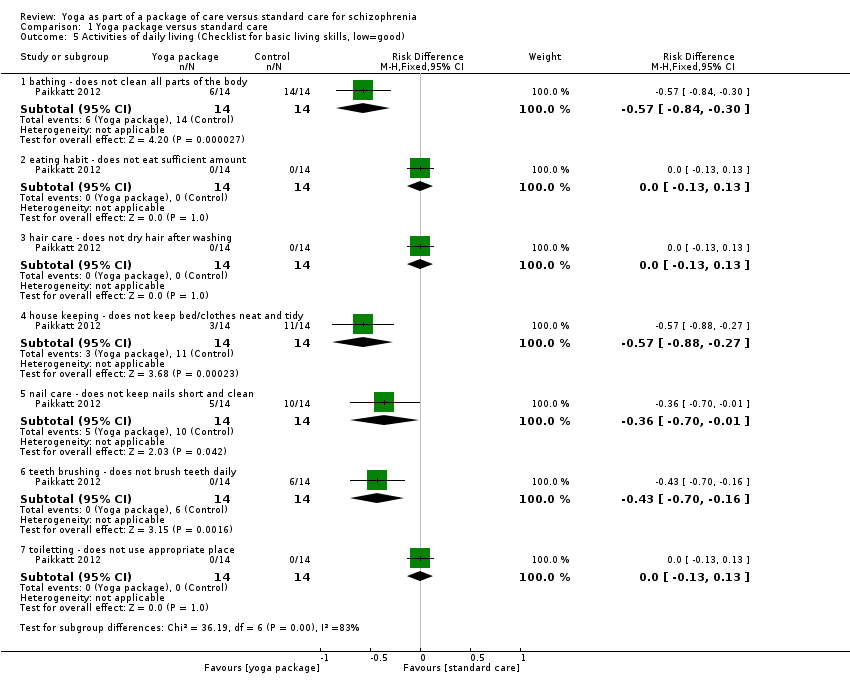Yoga como parte de un paquete de atención versus la atención habitual para la esquizofrenia
Información
- DOI:
- https://doi.org/10.1002/14651858.CD012145.pub2Copiar DOI
- Base de datos:
-
- Cochrane Database of Systematic Reviews
- Versión publicada:
-
- 29 septiembre 2017see what's new
- Tipo:
-
- Intervention
- Etapa:
-
- Review
- Grupo Editorial Cochrane:
-
Grupo Cochrane de Esquizofrenia
- Copyright:
-
- Copyright © 2018 The Cochrane Collaboration. Published by John Wiley & Sons, Ltd.
Cifras del artículo
Altmetric:
Citado por:
Autores
Contributions of authors
Julie Broderick ‐ writing and development of the protocol and review.
Davy Vancampfort ‐ assisting in writing the protocol and review.
Sources of support
Internal sources
-
No sources of support supplied
External sources
-
Health Research Board, Ireland, Ireland.
This review was conducted as part of a series of reviews which were funded by a Cochrane Fellowship Grant (CFT‐2014‐880) from the Health Research Board, Ireland (HRB).
Declarations of interest
Julie Broderick ‐ none at time of writing the protocol or review.
Davy Vancampfort ‐ none at time of writing the protocol or review.
Acknowledgements
The authors thank Professor Clive E Adams for the opportunity to perform this series of reviews and for his advice throughout, as well as the editorial staff of Cochrane Schizophrenia, particularly Claire Irving, for their support in the writing of the protocol. The Cochrane Schizophrenia Group produces and maintains standard text for use in the Methods section of their reviews, and the authors have used this text as the basis of what appears here, adapting it as required. The authors would also like to thank Jonathan Moran for his assistance with this review.
The authors also thank the Information Specialist of Cochrane Schizophrenia, Farhad Shokraneh, for his assistance with the searching.
Thank you to Li Jing, Bo Li, Sun Xueji, Shen Jing, and Zang Qing for peer reviewing the draft versions of this review.
Version history
| Published | Title | Stage | Authors | Version |
| 2017 Sep 29 | Yoga as part of a package of care versus standard care for schizophrenia | Review | Julie Broderick, Davy Vancampfort | |
| 2016 Apr 06 | Yoga as part of a package of care versus standard care for schizophrenia | Protocol | Julie Broderick, Niall Crumlish, Davy Vancampfort | |
Differences between protocol and review
1. Interventions
We have given brief explanations of the other therapies yoga could be combined with to form a package of care.
2. Outcomes
We have and renamed outcomes to be consistent with our other yoga reviews ‐ for example, in the protocol we had listed some as 'clinically significant' response and others as clinically important change ‐ the relevant outcomes are now all clinically important change. These changes do not affect the type of outcomes considered or type of data extracted. In line with the latest methods template for Cochrane Schizophrenia reviews, we have clarified that outcomes in 'Summary of findings' tables should be clinically important data but if such data are not available, we will use the closest outcome available but take this into consideration when assessing the quality of evidence for such outcomes.
We used RD rather than RR to allow visualisation of data on the graph. By using this we are able to see the trial but no material difference is made to the outcome or the conclusion regarding the outcome.
Keywords
MeSH
Medical Subject Headings (MeSH) Keywords
Medical Subject Headings Check Words
Humans;
PICO

Study flow diagram.

'Risk of bias' graph: review authors' judgements about each risk of bias item presented as percentages across all included studies.

'Risk of bias' summary: review authors' judgements about each risk of bias item for each included study.
| Study | Variable | Yoga package, median (interquartile range) (n = 33) | Control (median, interquartile range) (n = 40) |
| Isuru 2015 | PANSS positive | 15.0 (10.0 to 17.5) | 16.0 (14.0 to 18.0) |
| Isuru 2015 | PANSS negative | 17.0 (11.0 to 22.5) | 18.0 (15.0 to 22.0) |
| Isuru 2015 | PANSS total | 61.0 (49.5 to 72.0) | 63.5 (54.5 to 72.8) |
Comparison 1 Yoga package versus standard care, Outcome 1 Mental state: 1. Average score (PANSS, low = good).
| Study | Sub‐sections | Yoga Package (n = 14) | Control (n = 14) |
| Paikkatt 2012 | Not feeling happiness | 0 | 9 |
| Paikkatt 2012 | Not feeling satisfied | 4 | 4 |
| Paikkatt 2012 | Inadequate sleep | 2 | 2 |
| Paikkatt 2012 | Feeling good | 1 | 7 |
| Paikkatt 2012 | Not in control of anger | 1 | 3 |
| Paikkatt 2012 | Not feeling worthy | 1 | 7 |
| Paikkatt 2012 | Not feeling healthy | 0 | 4 |
Comparison 1 Yoga package versus standard care, Outcome 2 Global state: General well‐being: not improved (PGI general well‐being measure, low = good).

Comparison 1 Yoga package versus standard care, Outcome 3 Quality of life: Average end‐point score (GQOLI‐74, high = good) short term.

Comparison 1 Yoga package versus standard care, Outcome 4 Leaving the study early: any reason (low = good) short term.

Comparison 1 Yoga package versus standard care, Outcome 5 Activities of daily living (Checklist for basic living skills, low=good).
| Methods | Allocation: randomised (clearly described). |
| Participants | Diagnosis: people with a clinical diagnosis of schizophrenia using DSM‐IV criteria. |
| Interventions | 1. Yoga: the yoga intervention should be clearly described and consist of the following components: (i) shithileekarana vyayama (loosening exercises) for approximately 10 minutes, (ii) yoga postures (asanas) for approximately 20 minutes, (iii) breathing exercises and relaxation techniques for approximately 20 minutes using a manualised protocol, yoga programme for 12 weeks, 3 times weekly, follow‐up at 6 months and 1 year, yoga delivered by a trained yoga instructor, meditation not included. 2. Standard‐care control. All groups stable pharmacotherapy. |
| Outcomes | Mental state (binary outcomes). Relapses (binary outcomes). Quality of life (binary outcomes). Disability (binary outcomes). Activities of daily living (binary outcomes). Costs: cost of services, cost of care. Adverse events related to yoga (number and type of injuries). Service outcomes: days in hospital, time attending outpatient psychiatric clinic. |
| Notes | Adherence should be logged with participants expected to adhere to 70% to 75% of scheduled sessions. |
| DSM‐IV:Diagnostic and Statistical Manual of Mental Disorders, Fourth Edition | |
| Yoga package versus standard care for schizophrenia | ||||||
| Patient or population: patients with schizophrenia | ||||||
| Outcomes | Illustrative comparative risks* (95% CI) | Relative effect | No of Participants | Quality of the evidence | Comments | |
| Assumed risk | Corresponding risk | |||||
| Control | Yoga package versus standard care | |||||
| Mental State: clinically important change | No useable mental state data reported. | |||||
| Social functioning: clinically important change | No study reported on social functioning. | |||||
| Adverse events: clinically important adverse effect | No study reported on adverse effects. | |||||
| Quality of life: clinically important change* Follow‐up: mean 4 weeks | The mean quality of life (GQOLI‐74) in the intervention groups was | 80 | ⊕⊕⊝⊝ | * Clinically important data not available: nearest outcome reported were Average endpoint scores on the GQOLI‐74 | ||
| Leaving the study early: any reason Leaving the study early: participants lost to follow‐up ‐ short term (low=good) | Low1 | 0.06 [‐ 0.01 to 0.13] | 193 (3 studies) | ⊕⊕⊕⊝ | ||
| 800 per 1000 | 1000 per 1000 (640 to 1000) | |||||
| Moderate1 | ||||||
| 900 per 1000 | 1000 per 1000 (720 to 1000) | |||||
| High1 | ||||||
| 1000 per 1000 | 1000 per 1000 (800 to 1000) | |||||
| Costs of care: direct and indirect | No study reported direct or indirect costs of care. | |||||
| Physical health: clinically important change | No study reported on physical health. | |||||
| *The basis for the assumed risk (e.g. the median control group risk across studies) is provided in footnotes. The corresponding risk (and its confidence interval) is based on the assumed risk in the comparison group and the relative effect of the intervention (and its CI). | ||||||
| GRADE Working Group grades of evidence | ||||||
| 1 Imprecision: Downgraded one level as a number of participants withdrew from two trials, not accounted for in final analysis. 3Imprecision: Downgraded one level due to relatively small number of participants included. | ||||||
| Review number | Review Title | Status |
| 1 | Yoga versus standard care for schizophrenia | |
| 2 | Yoga versus non‐standard care for schizophrenia | |
| 3 | Yoga as part of a package of care versus standard care | Current review |
| 4 | Yoga as part of a package of care versus non‐standard care |
| Intervention | Plus | Control | Participants | Reference tag | Proposed relevant Cochrane review |
| Yoga | Nil | Exercise | People with schizophrenia | Bhatia 2017; Duraiswamy 2007; Lin 2015; Manjunath 2013; Varambally 2012; JPRN‐UMIN000013746 | Yoga versus non‐standard care for schizophrenia |
| Counselling | Standard care | ||||
| Motivational and feedback session | |||||
| Nil | Caregivers of people with schizophrenia | ‐ | |||
| Yoga | Non‐standard care | People with schizophrenia | Yoga as part of a package of care versus non‐standard care | ||
| Chlorpromazine | Nil | Placebo | Chlorpromazine versus placebo for schizophrenia | ||
| 'Tagara' (local drug with antipsychotic properties) and 'Brahmyadiyoga' (an herbal compound) | Nil | Chlorpromazine | Chlorpromazine versus herbal compounds for schizophrenia |
| Outcome or subgroup title | No. of studies | No. of participants | Statistical method | Effect size |
| 1 Mental state: 1. Average score (PANSS, low = good) Show forest plot | Other data | No numeric data | ||
| 2 Global state: General well‐being: not improved (PGI general well‐being measure, low = good) Show forest plot | Other data | No numeric data | ||
| 3 Quality of life: Average end‐point score (GQOLI‐74, high = good) short term Show forest plot | 1 | 80 | Mean Difference (IV, Fixed, 95% CI) | 22.93 [19.74, 26.12] |
| 4 Leaving the study early: any reason (low = good) short term Show forest plot | 3 | 193 | Risk Difference (M‐H, Fixed, 95% CI) | 0.06 [‐0.01, 0.13] |
| 5 Activities of daily living (Checklist for basic living skills, low=good) Show forest plot | 1 | Risk Difference (M‐H, Fixed, 95% CI) | Subtotals only | |
| 5.1 bathing ‐ does not clean all parts of the body | 1 | 28 | Risk Difference (M‐H, Fixed, 95% CI) | ‐0.57 [‐0.84, ‐0.30] |
| 5.2 eating habit ‐ does not eat sufficient amount | 1 | 28 | Risk Difference (M‐H, Fixed, 95% CI) | 0.0 [‐0.13, 0.13] |
| 5.3 hair care ‐ does not dry hair after washing | 1 | 28 | Risk Difference (M‐H, Fixed, 95% CI) | 0.0 [‐0.13, 0.13] |
| 5.4 house keeping ‐ does not keep bed/clothes neat and tidy | 1 | 28 | Risk Difference (M‐H, Fixed, 95% CI) | ‐0.57 [‐0.88, ‐0.27] |
| 5.5 nail care ‐ does not keep nails short and clean | 1 | 28 | Risk Difference (M‐H, Fixed, 95% CI) | ‐0.36 [‐0.70, ‐0.01] |
| 5.6 teeth brushing ‐ does not brush teeth daily | 1 | 28 | Risk Difference (M‐H, Fixed, 95% CI) | ‐0.43 [‐0.70, ‐0.16] |
| 5.7 toiletting ‐ does not use appropriate place | 1 | 28 | Risk Difference (M‐H, Fixed, 95% CI) | 0.0 [‐0.13, 0.13] |

